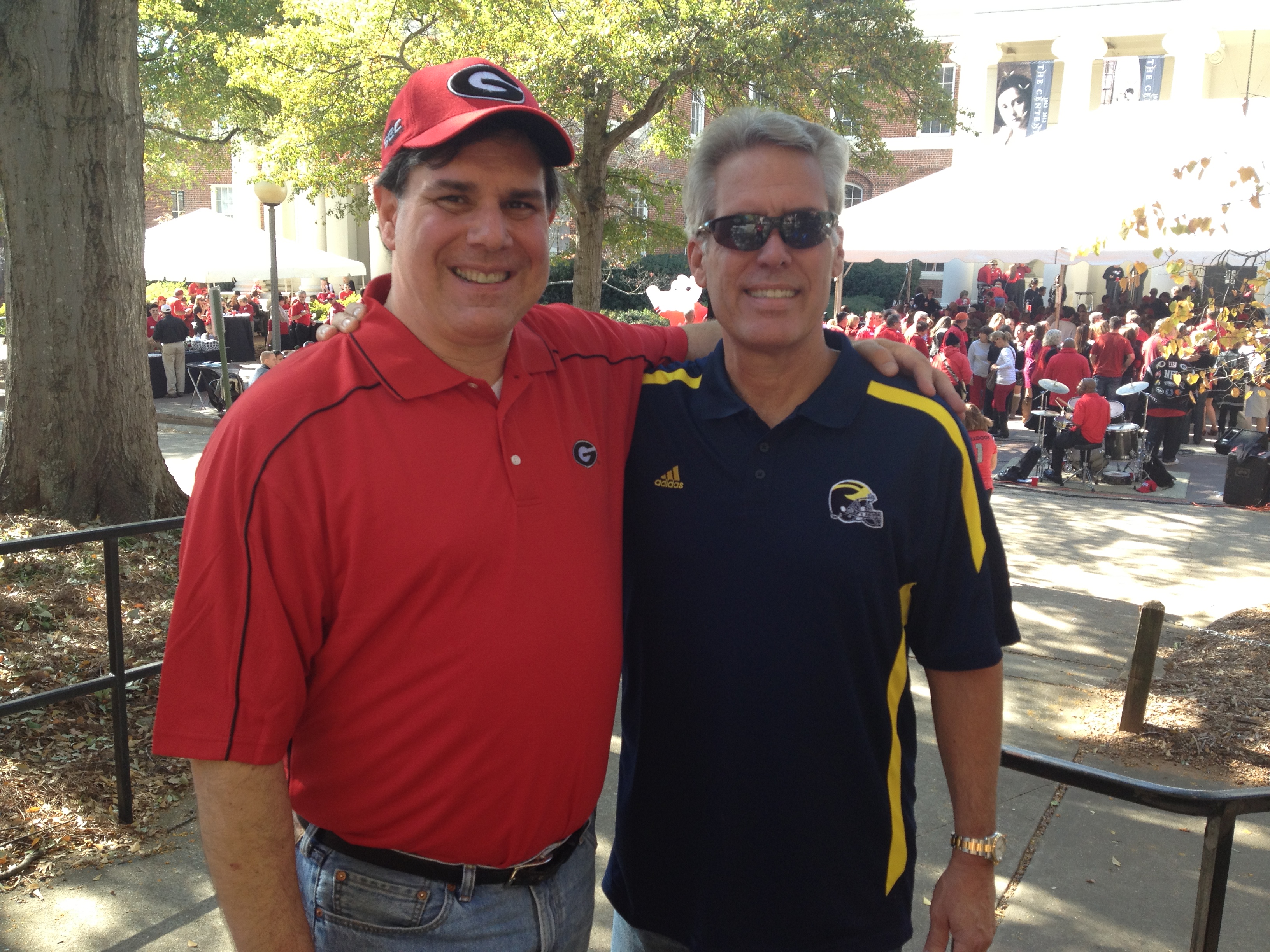
2012 Georgia - 37 vs. Old Miss - 10: The Dawging It Tour
Ah Athens! One of the classics!, No,,, not Greece, Georgia !!! The place where B-52 is more than a drink and bulldogs are not butt ugly !! Yes, Athens, one of the coolest College Towns in North America that spawned the B-52's and REM. Mike and Bone had been threatening an Athen's campaign for quite some time, and 2012 was the year ! Flying into the ATL, they staged their campaign by draining beers at Jay Houghton's Farm in Marietta, then stayed in a Hotel that Norman Bates wouldn't stay at. Touring an awesome campus, Mike and Bone checked out all the traditions of the Bulldogs as they torched the Ole Miss Rebels and thoroughly did their best to make the College students groan due to the lack of beer in town due to the ravages of Mike and Bone!!
A Bull-headed Dawg and Wolverine on UGA's Campus !

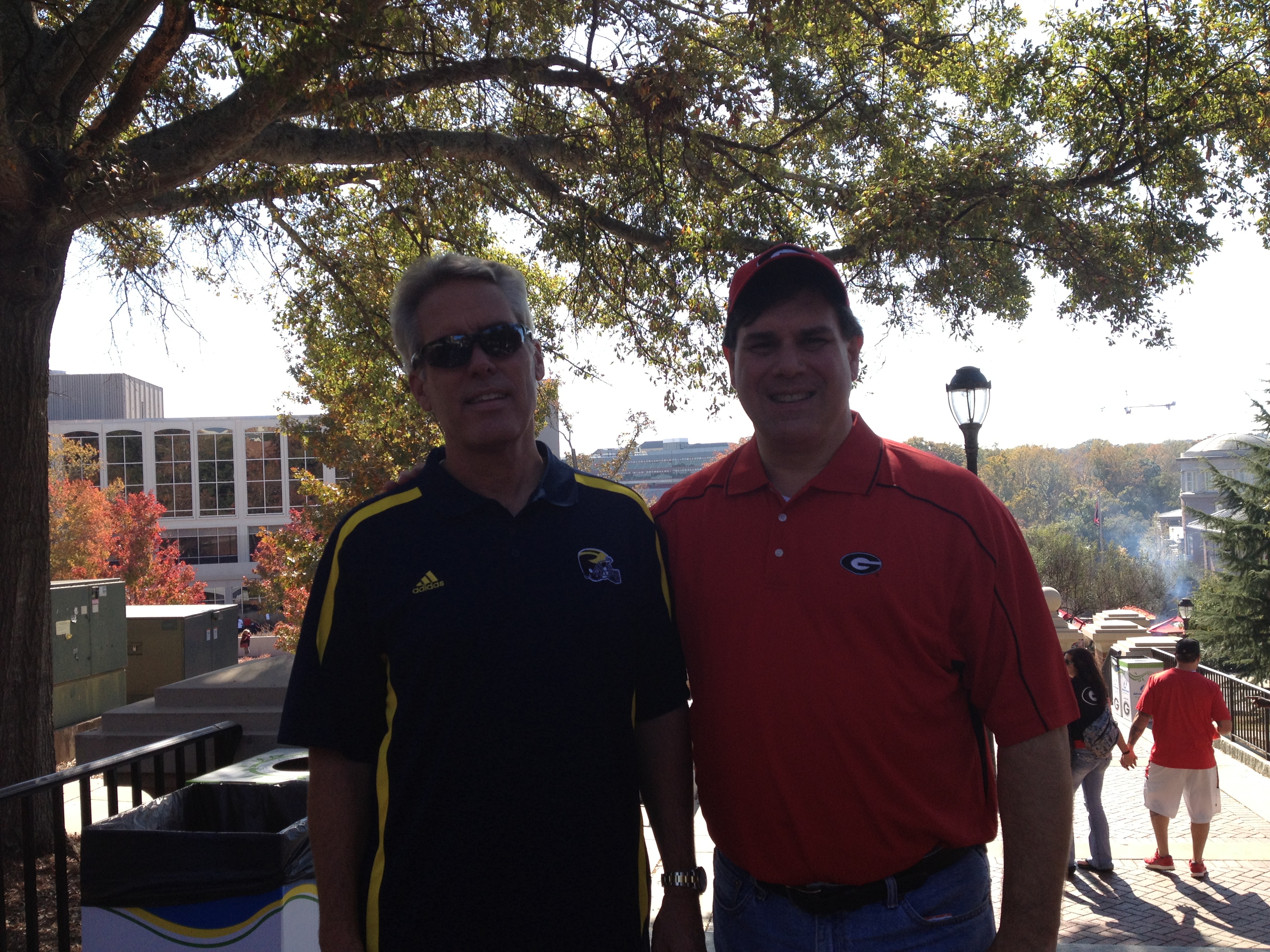
With their heads clearing from the Night beforeand the day looking awesome, the Boys decided to walk around the venerable University of Georgia Campus. The University of Georgia was incorporated on January 27, 1785, and became the first state to charter a state-supported university. Walking around on Homecoming Weekend definitely gave Mike and Bone a feel of Georgia. After an hour the Boy started for venerable Sanford Stadium.
Venerable Sanford Stadium
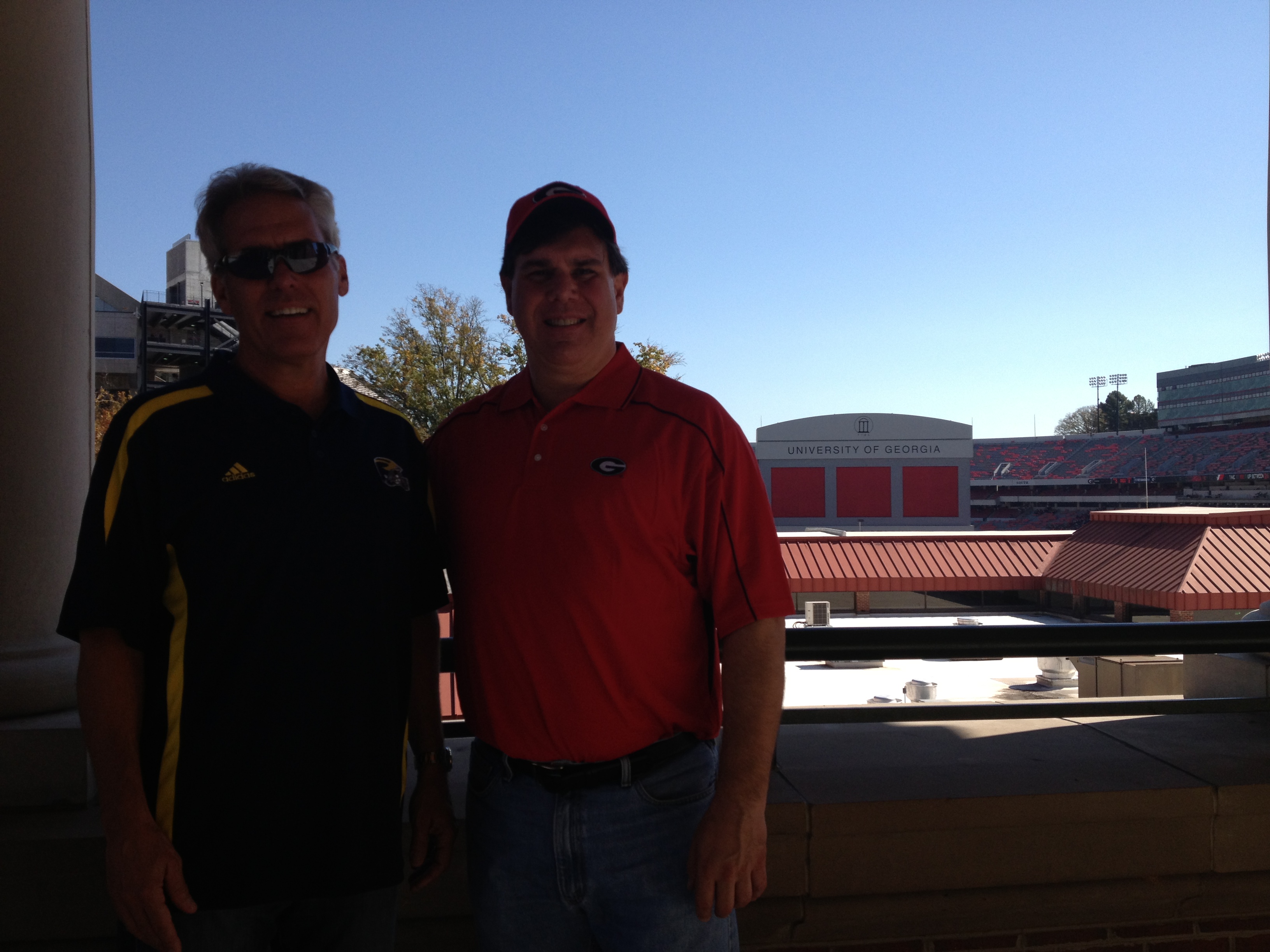
While Sanford Stadium is no Big House, with a $25 million expansion completed in 2003 and another $8 million in 2004, Sanford Stadium added a second upper deck on the north side and 27 new north side SkySuites brought the stadium capacity to 92,746, the fifth largest on-campus stadium in the country.
Architecturally, the stadium is known for the fact that its numerous expansions over the years have been carefully planned to fit with the existing "look" of the stadium. Games played there are said to be played "Between the Hedges" due to the privet hedges, which have stood around the field since its opening day in 1929. An early major force behind UGA athletics, the stadium's namesake, Dr. Steadman Vincent Sanford, arrived at the university as an English instructor in 1903. He later became the faculty representative to the athletics committee and would eventually become president of the University and Chancellor of the entire University System of Georgia.
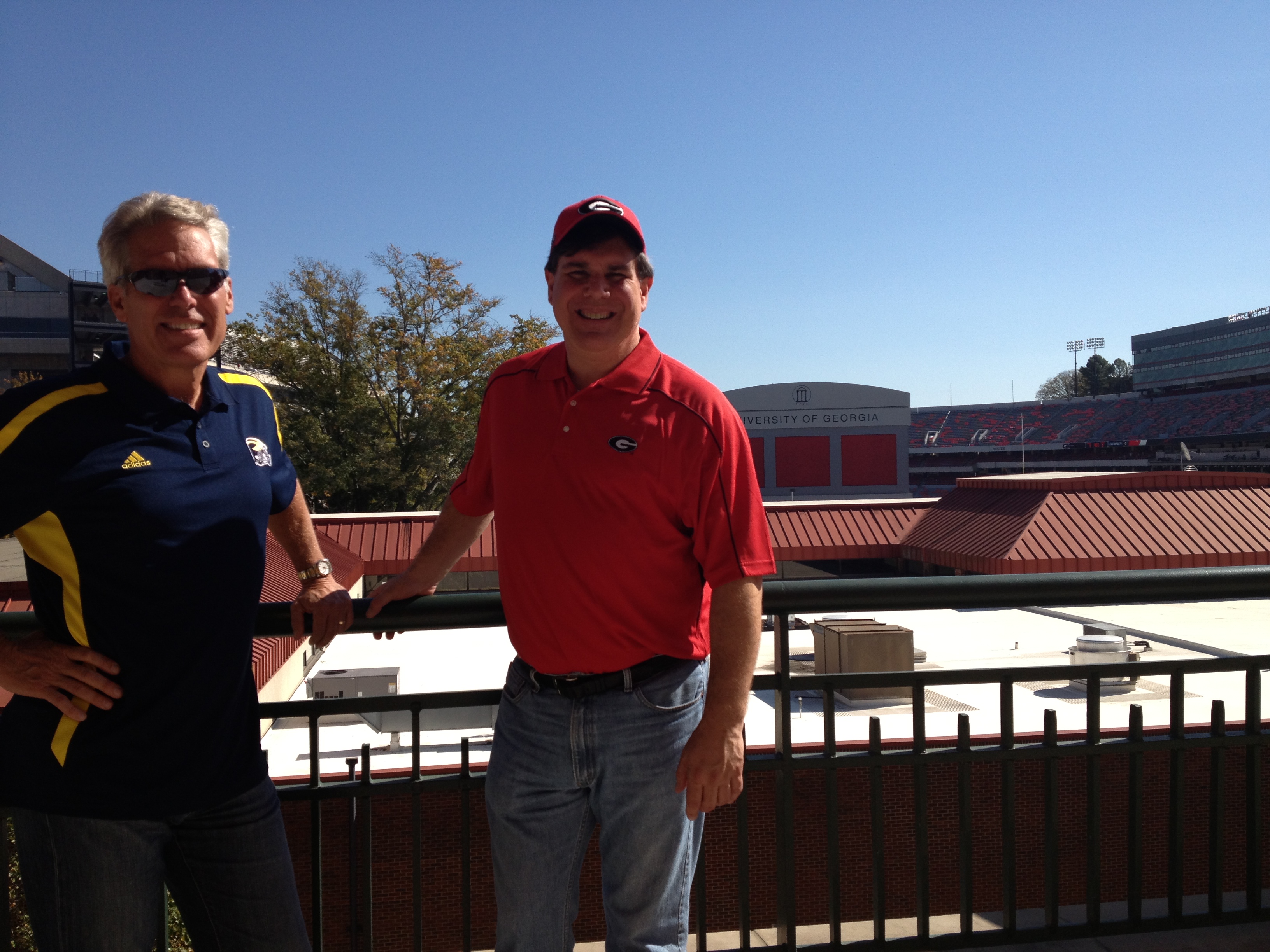
In 1911, he moved the university's football venue from its first location, Herty Field, to a location at the center of campus which was named Sanford Field in his honor. In those early years of football, Georgia played a series of controversial games against in-state rival Georgia Tech. Tech's Grant Field in Atlanta held thousands of spectators, and Georgia was forced to play those match-ups almost exclusively at Tech's stadium. Sanford wanted Georgia to have a venue that would equal Tech's, and the "final straw" came in 1927 when UGA's undefeated (9-0) team traveled to Tech and lost 12-0. It was alleged that Tech watered the field all night to slow UGA's running backs. Afterwards, Sanford vowed to "build a stadium bigger than Tech," and play the game at Athens every other year. To fund his vision, Sanford had an idea that members of the athletic association would sign notes guaranteeing a bank loan to fund the stadium construction. Those guarantors would be granted lifetime seats. The response was overwhelming, and in 1928 a loan of $150,000 supported by fans and alumni allowed construction to begin on a stadium whose total cost was $360,000.
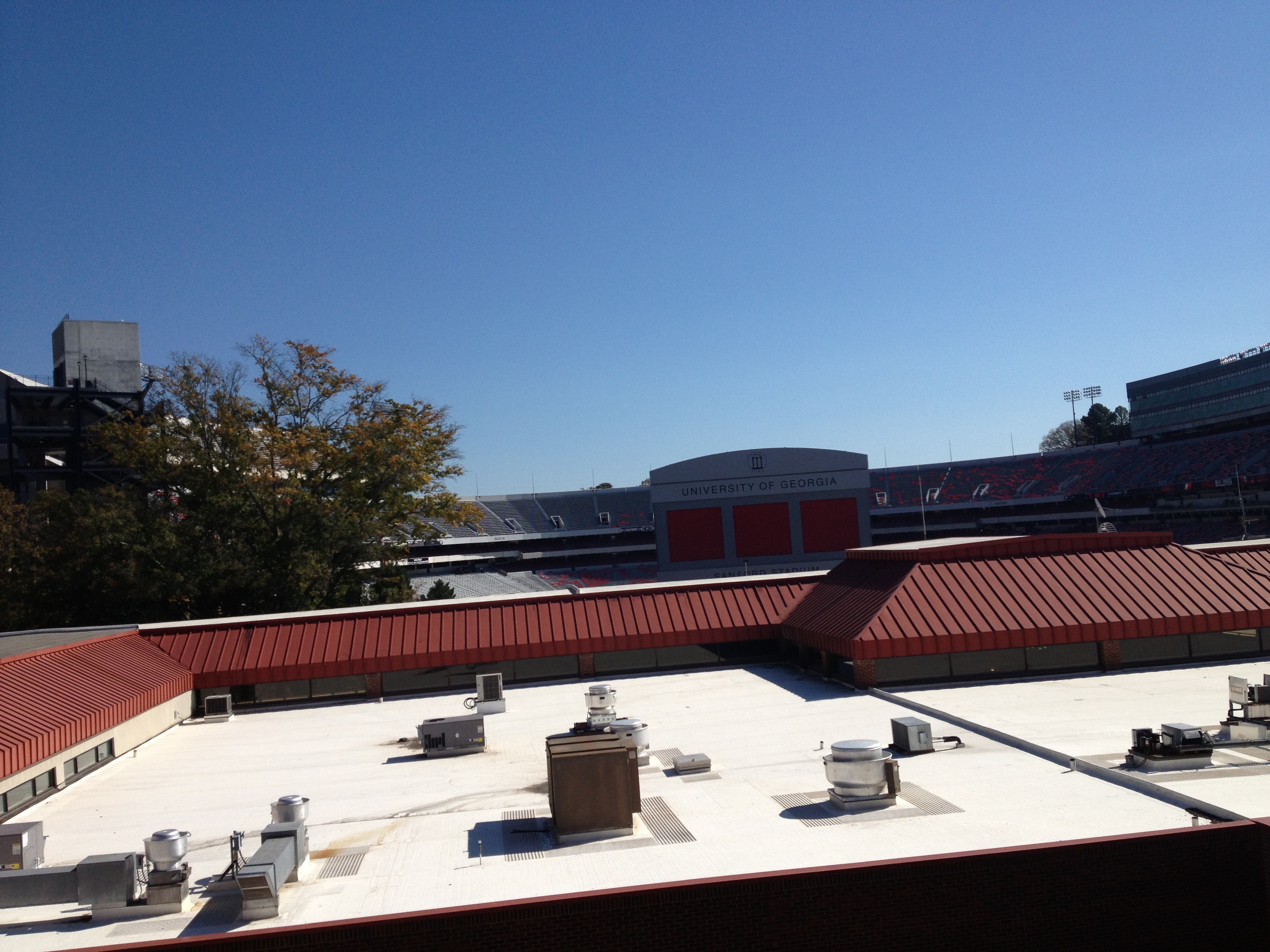
Near the existing Sanford Field was a low area between the Old Campus (to the north) and the Ag Campus (to the south) with a small creek (Tanyard Creek) running through it, creating a clearly preferable choice for the locaiton of the new stadium. This natural valley containing Tanyard Creek would result in reduced costs, as stands could be built on the rising sides of the hill, while the creek could be enclosed in a concrete culvert, on top of which the field would be constructed. The architect for the stadium was TC Atwood of Chapel Hill, North Carolina, where North Carolina's Kenan Stadium had just been completed with a similar design. The 30,000 seat stadium was built in large part with convict labor, as were many public works projects of that era. The stadium was completed on time, and UGA convinced perennial powerhouse Yale, with whom the University had historically maintained close ties, to be their first opponent in the new stadium. (This also was Yale's first ever football game played in the South.) On October 12, 1929, a capacity crowd of 30,000+ paid $3.00 per ticket to watch the Georgia Bulldogs, under coach Harry Mehre, beat Yale 15-0 in Sanford Stadium's dedication game. Yale donated its half of the game receipts to UGA to help pay off the construction loans, which would subsequently be completely repaid in just five years. Dr. Sanford also was at this game, and attended many Georgia games at the stadium named in his honor until his death on September 15, 1945.
The very cool Dawg Walk
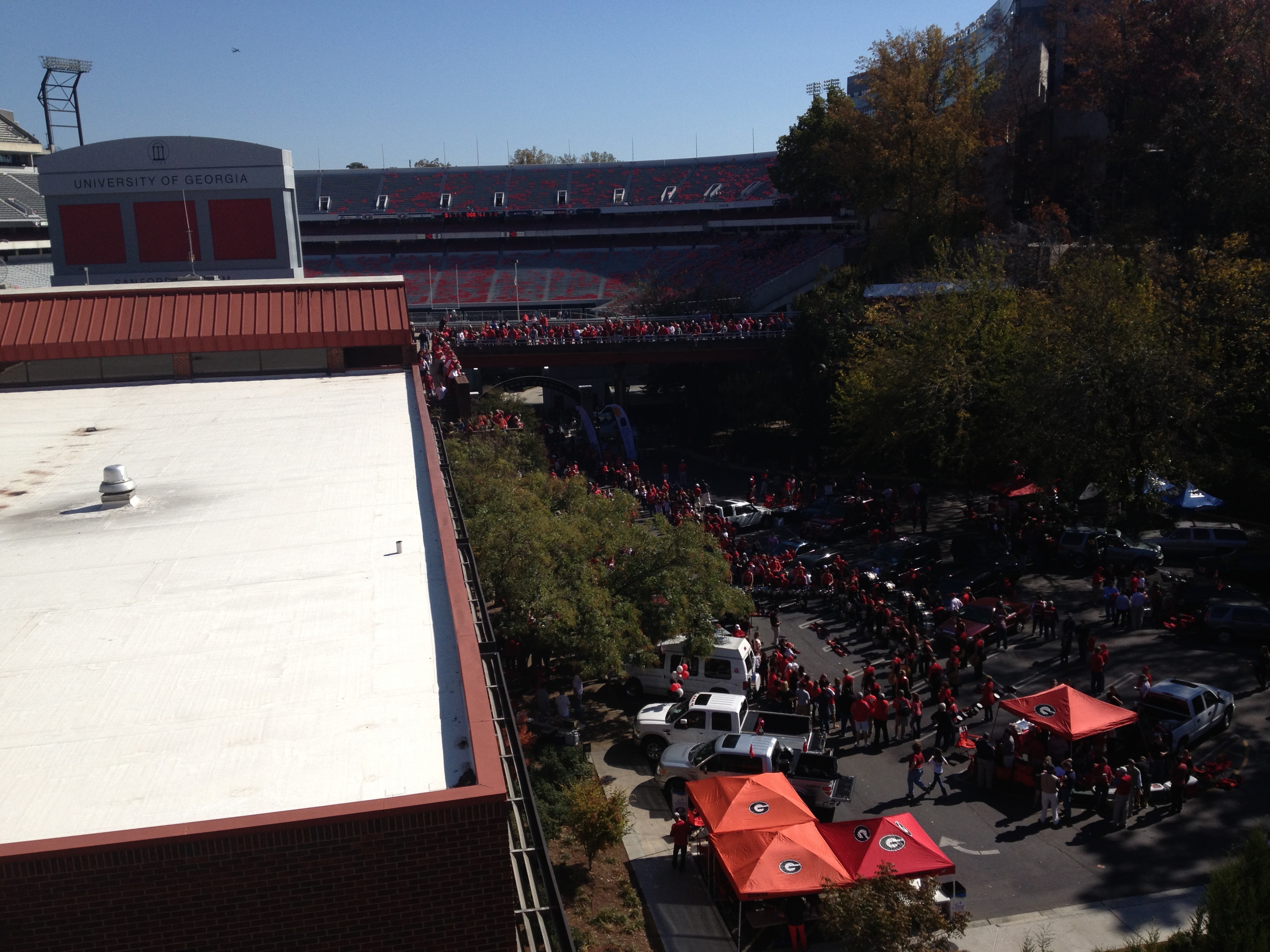
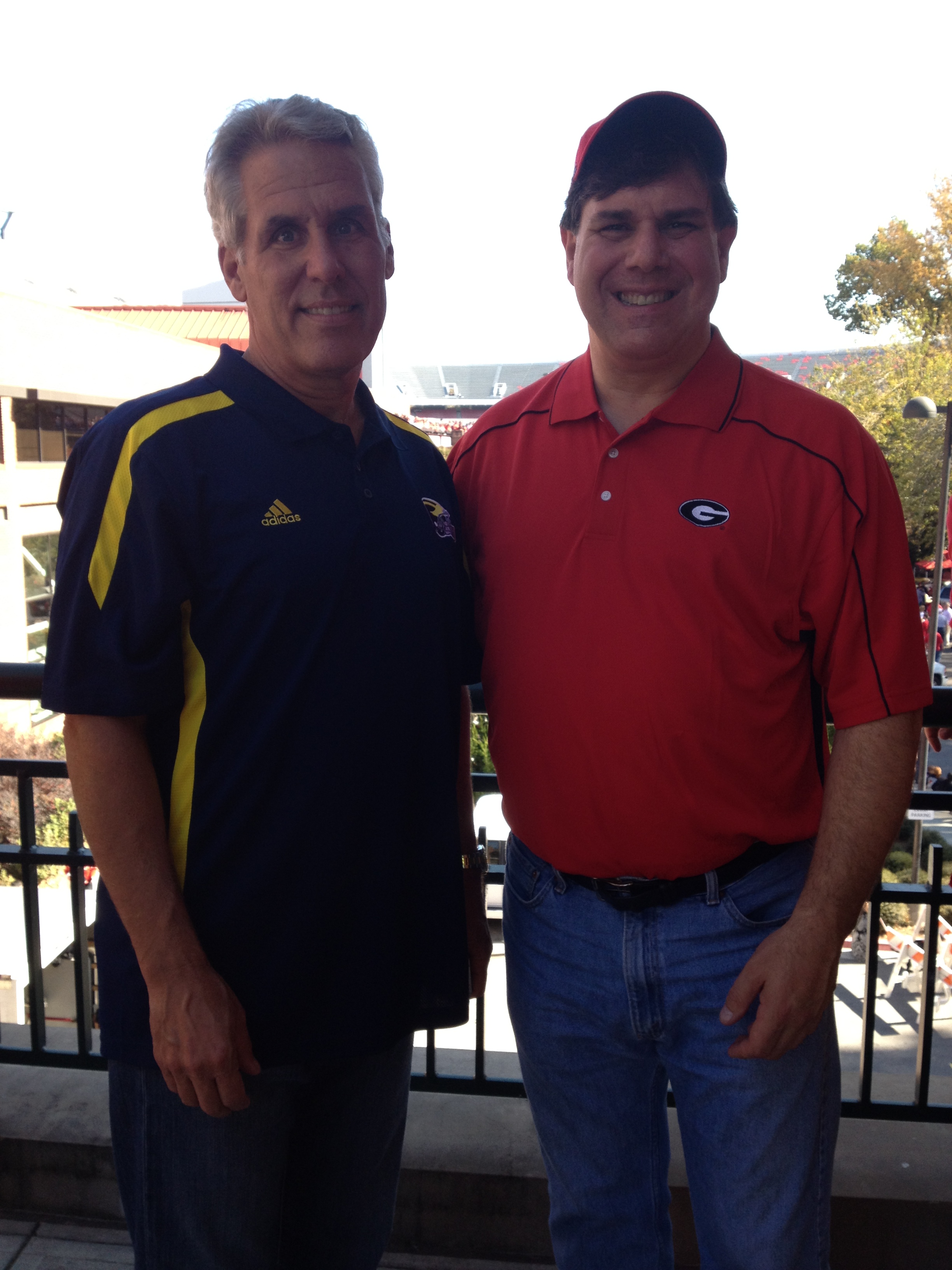
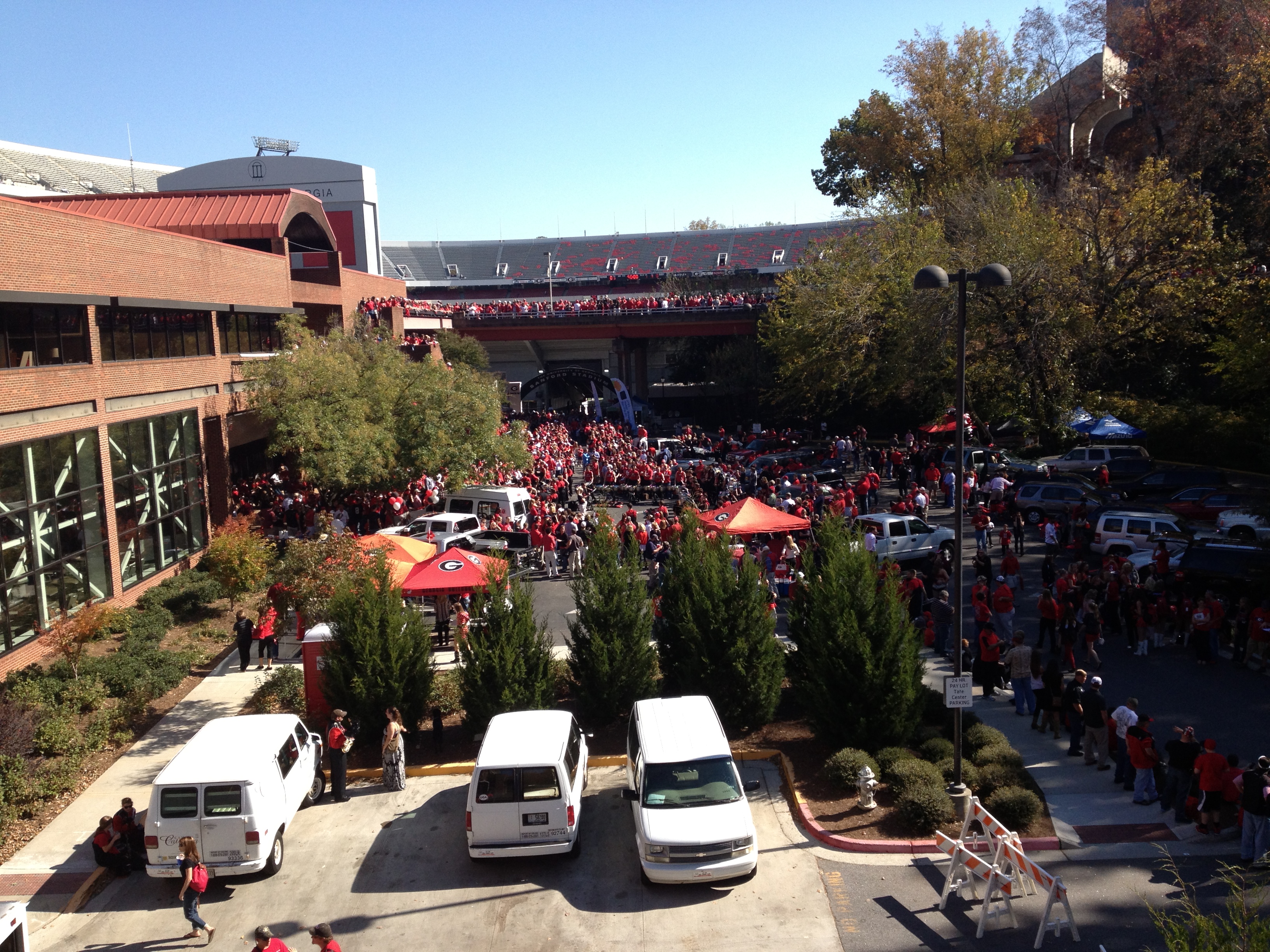
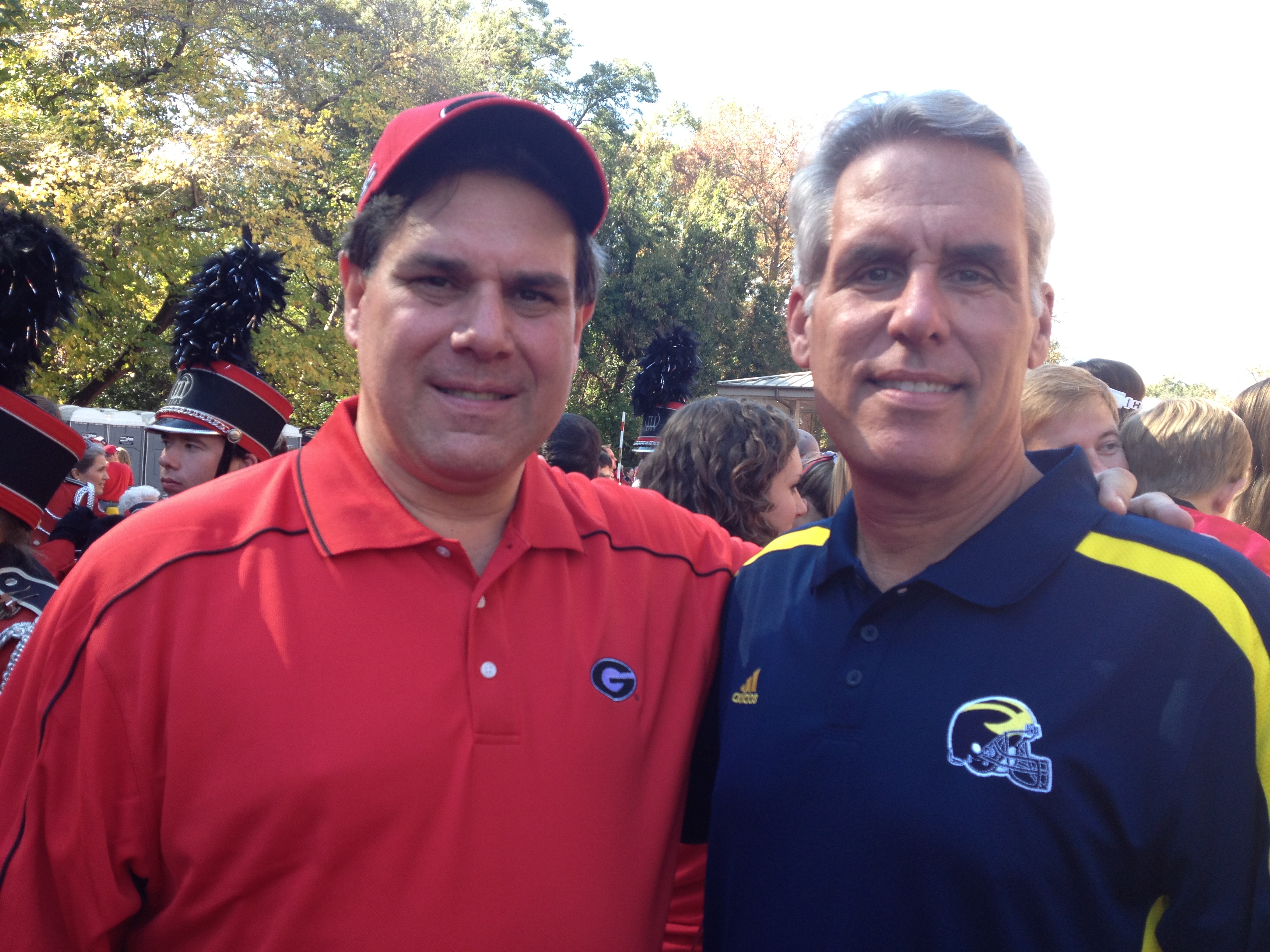
Next, the Boys wanted to check out a famous pre-game tradition, the Dog Walk! The Dog Walk is pregame ritual where the Georgia Red Coat Band splits along the sidewalk to Sanford Stadium and performs as the coaches and players walk to the stadium. It is very cool and Mike and Bone enjoy the whole atmosphere!
The Marching Red Coat Band !
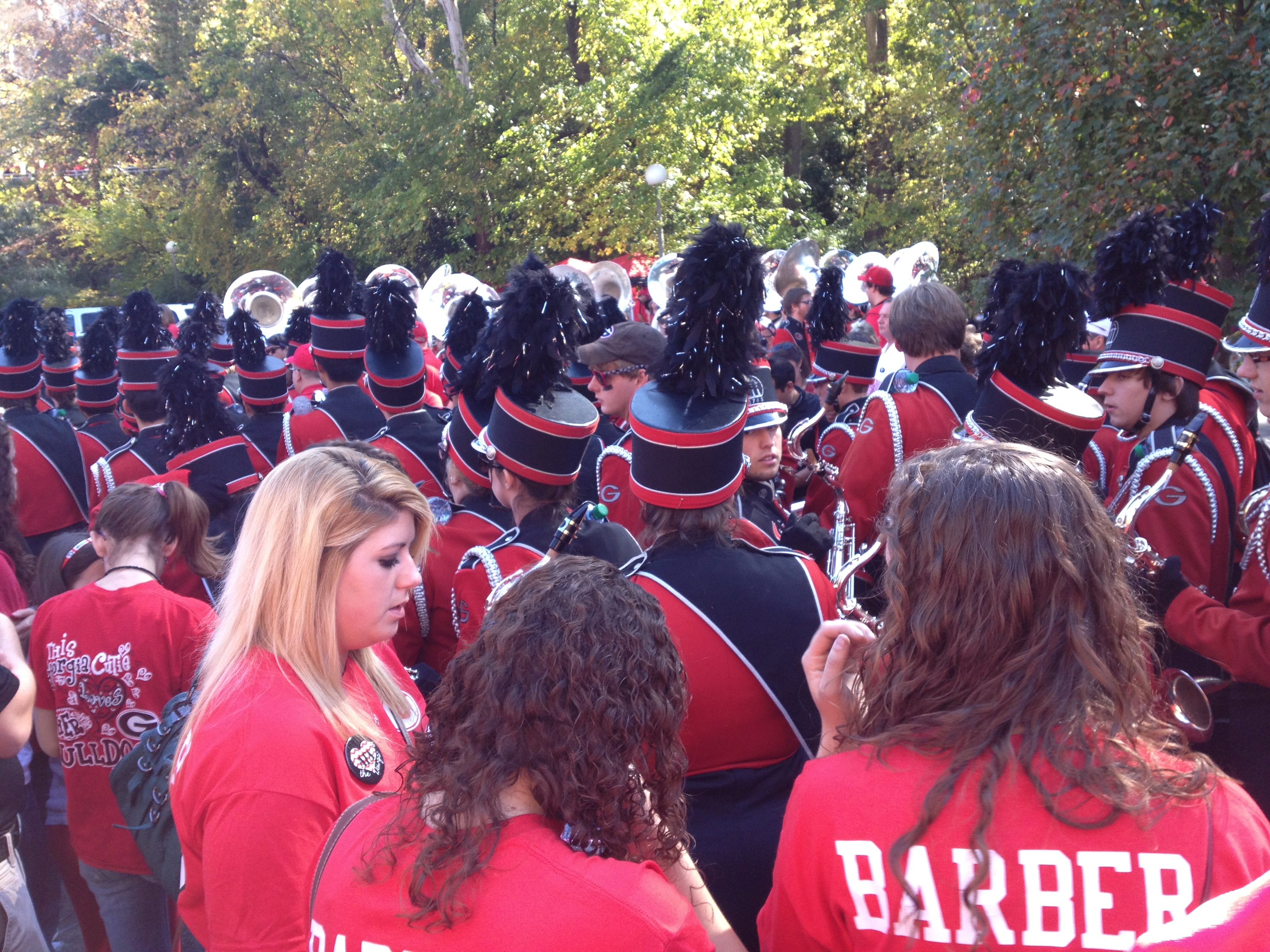
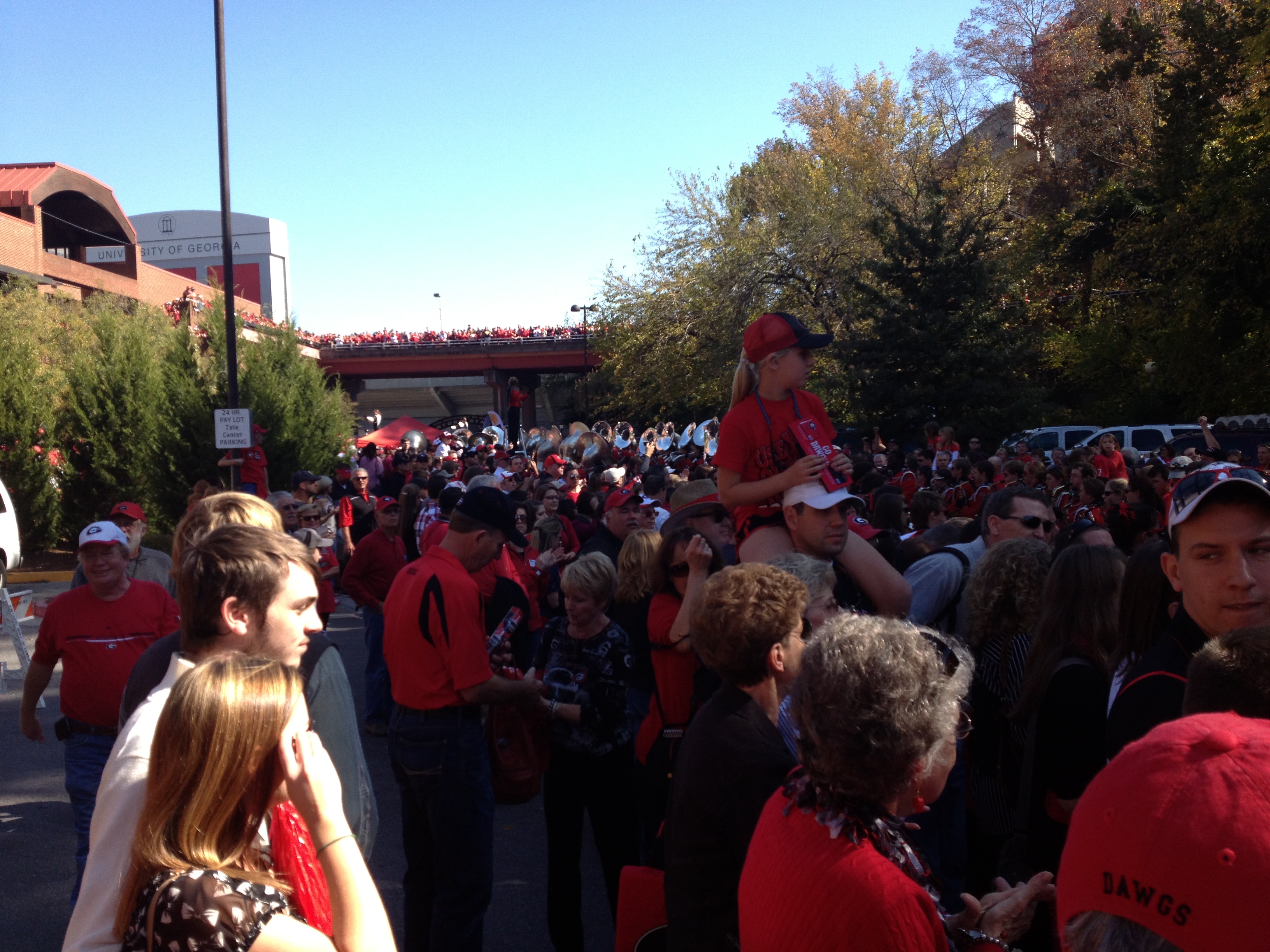
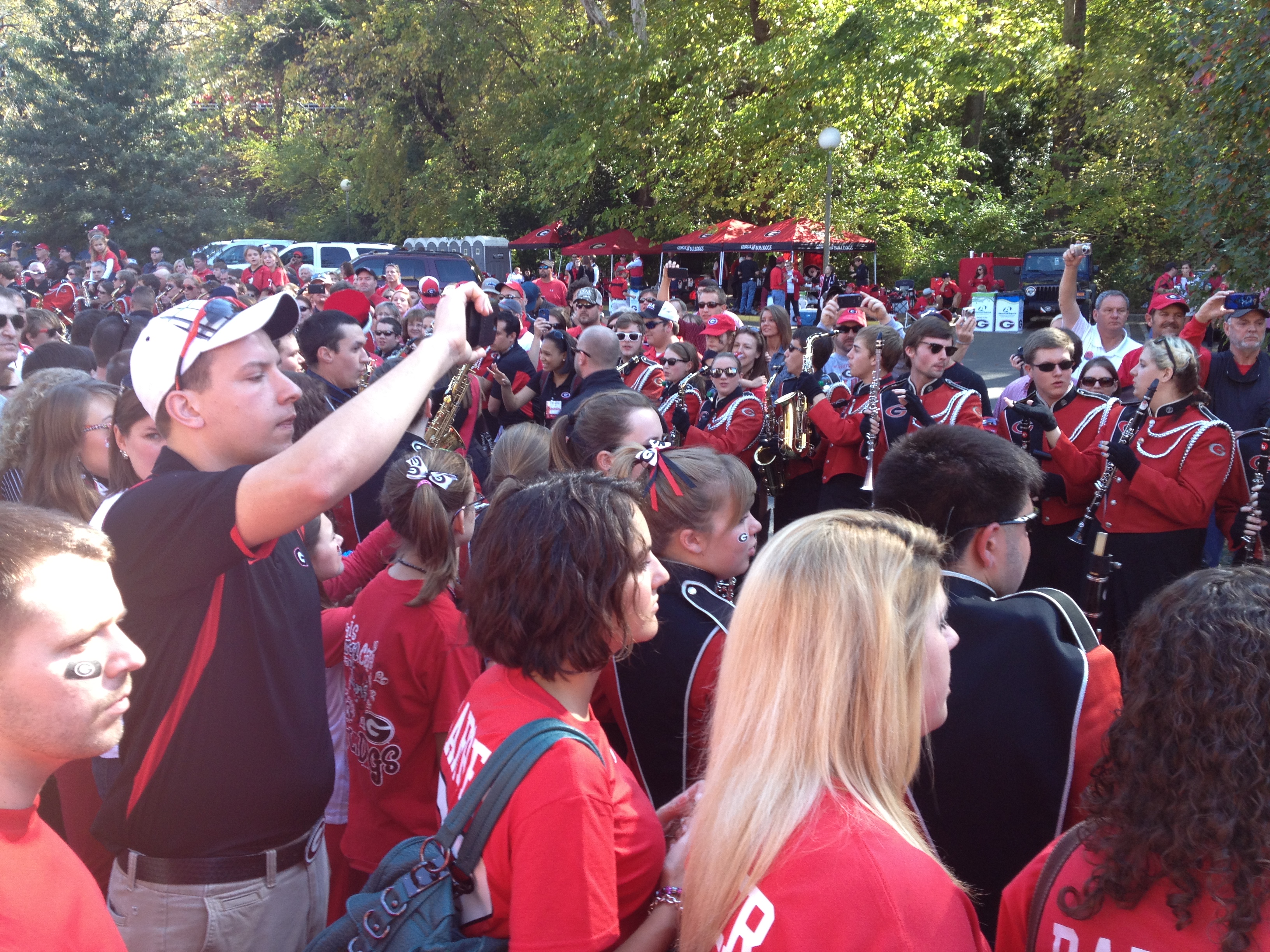
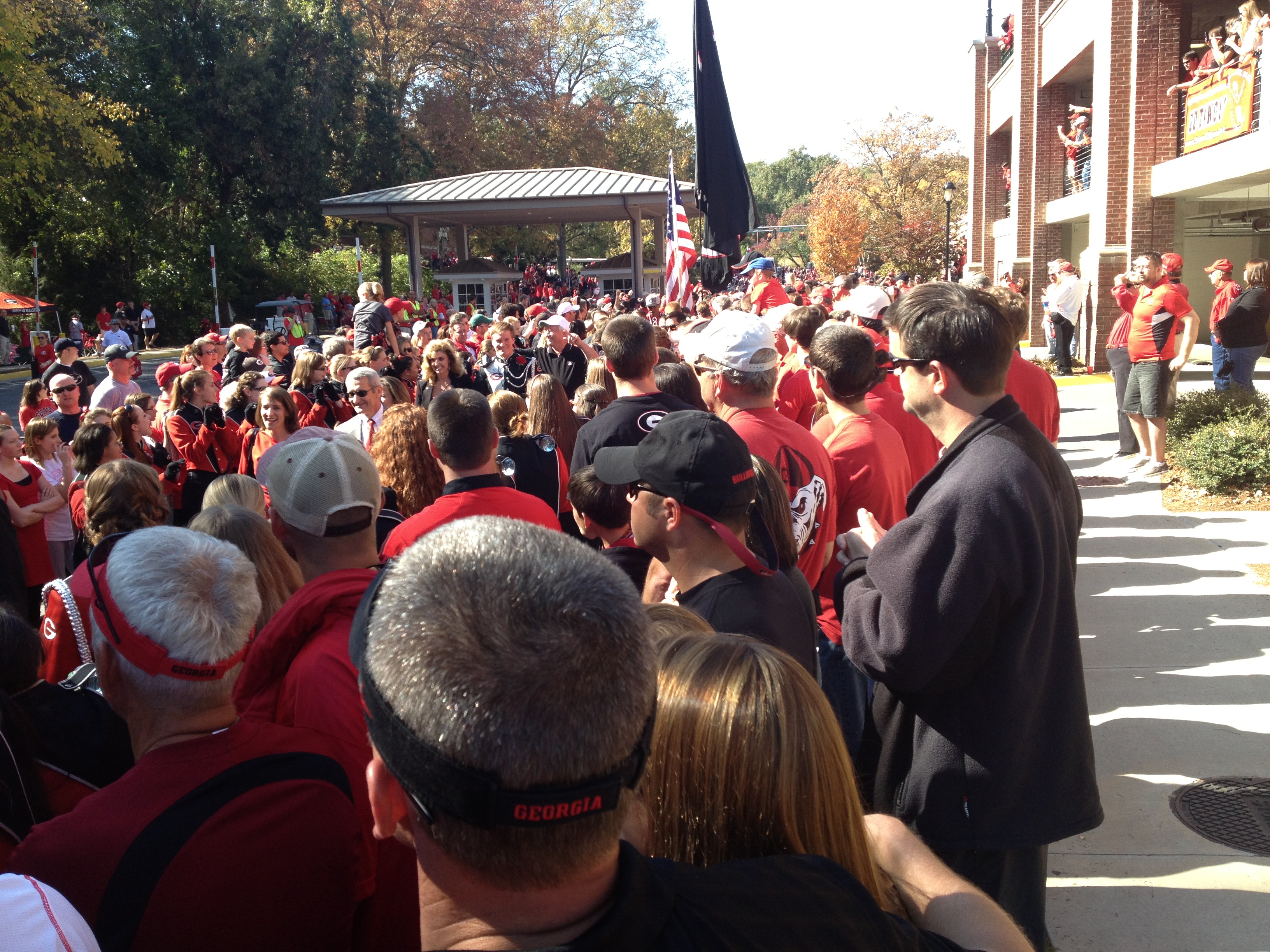
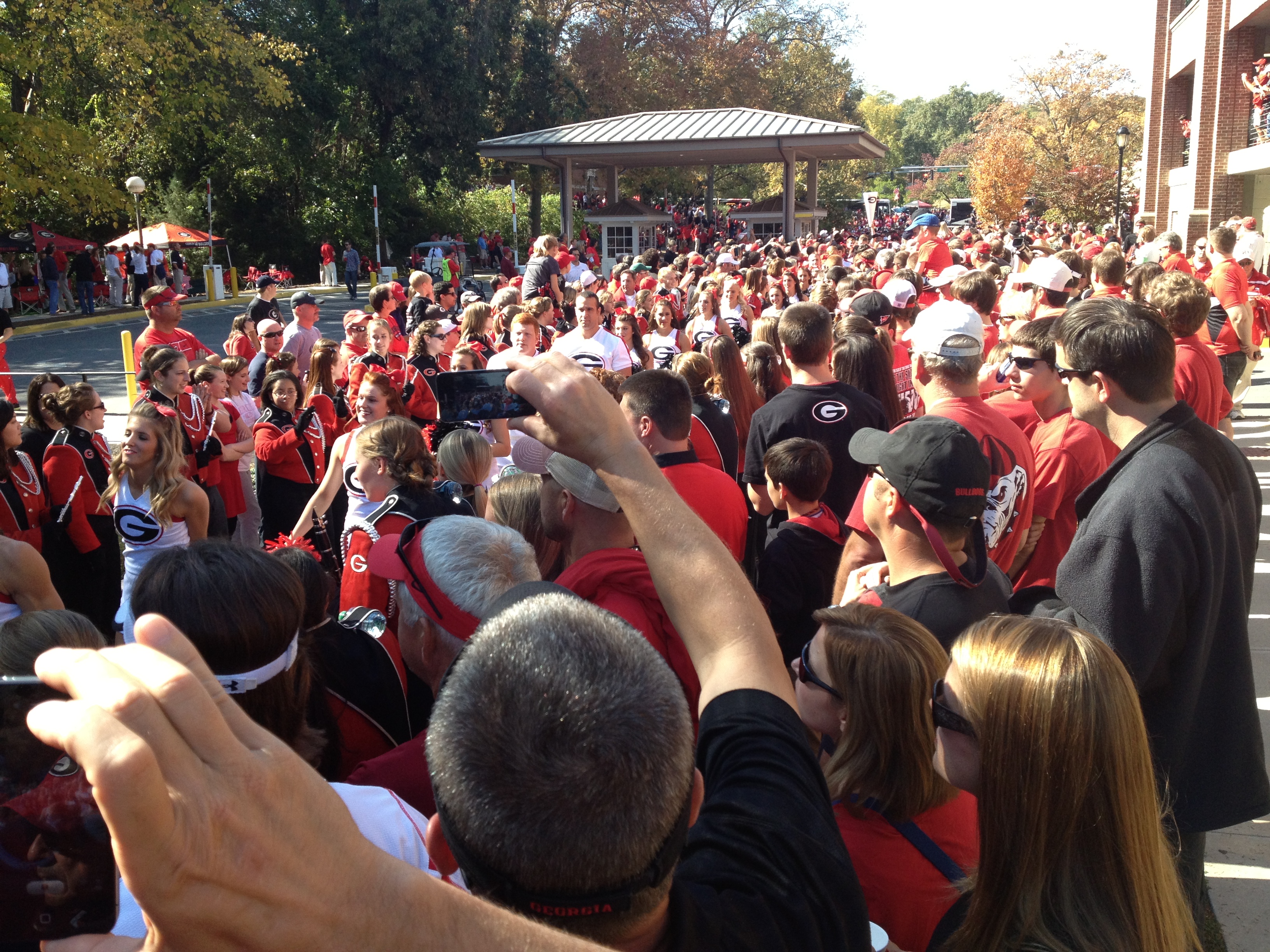
The Georgia Mascot: Harry Paws !
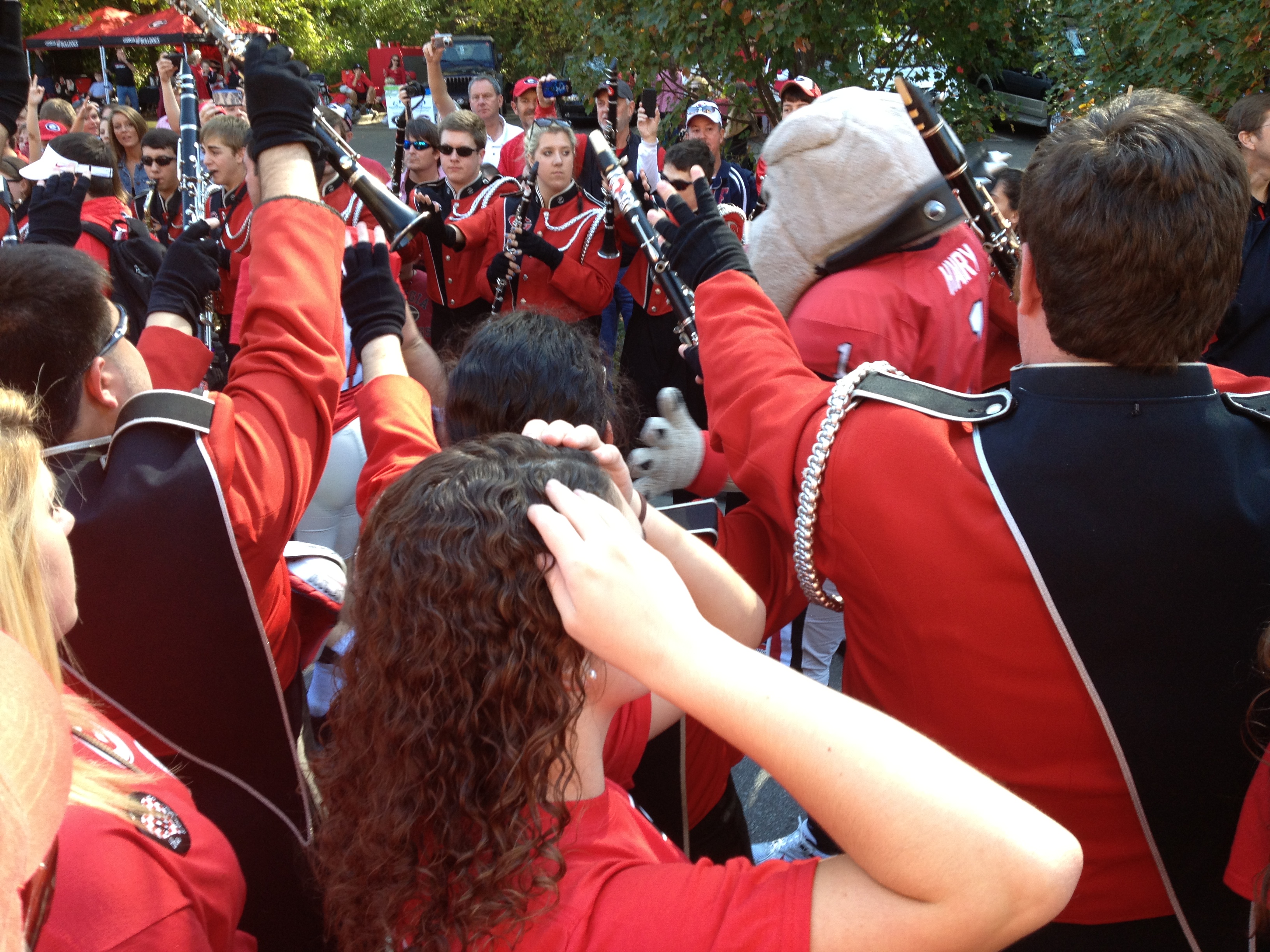
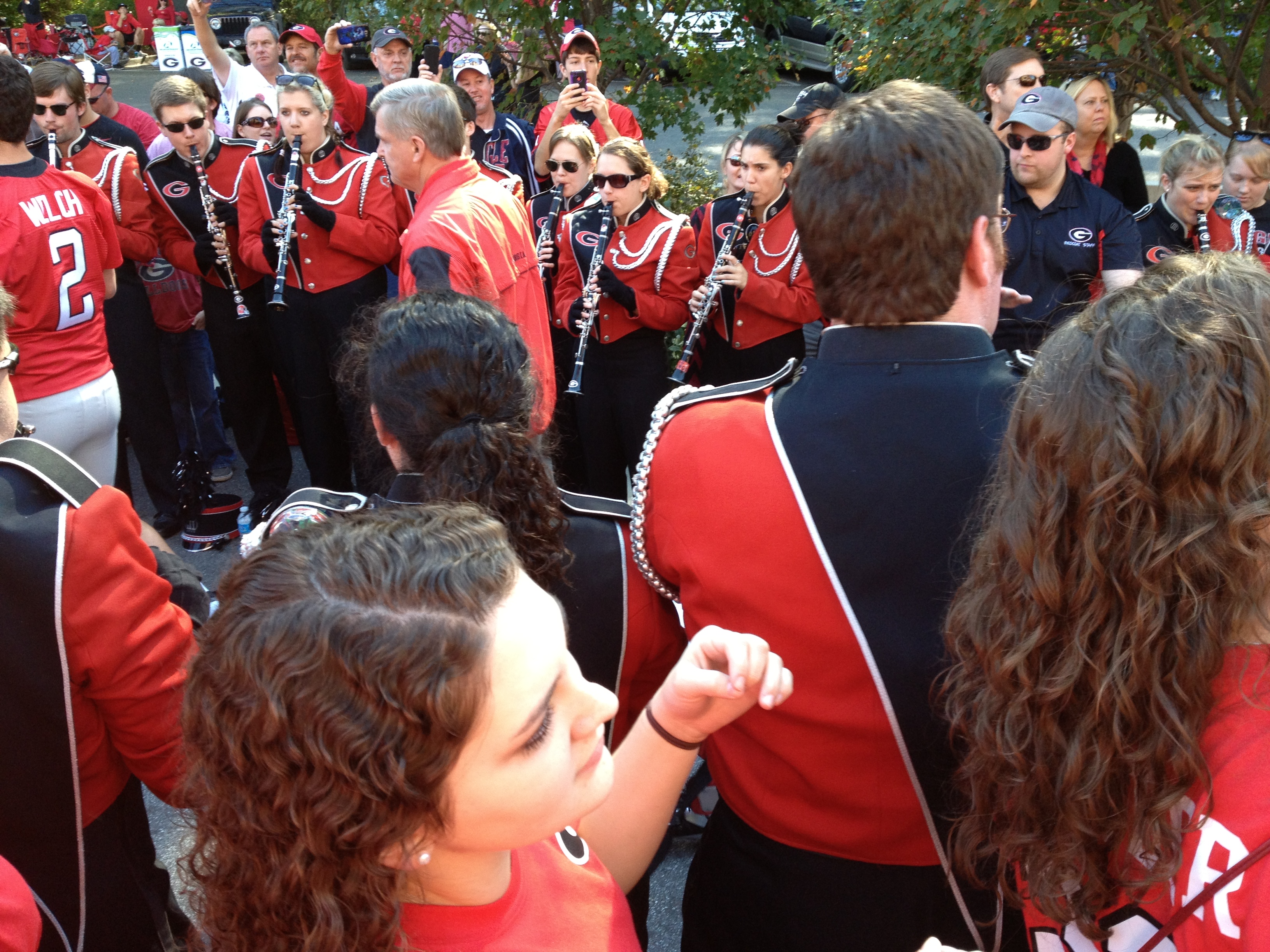
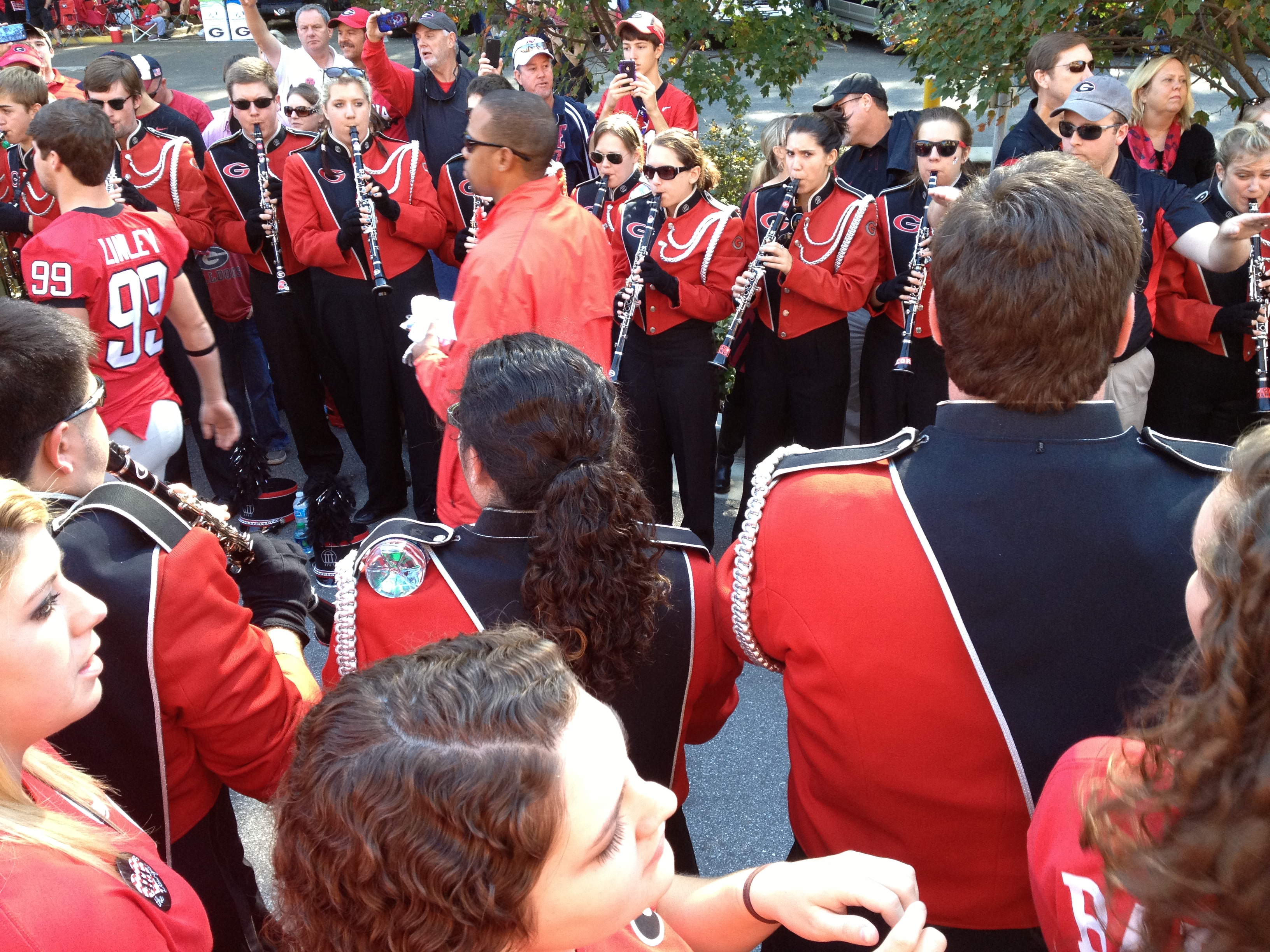
The Lone Playa!

A cool part of the Dawg Walk is when the Band plays the Alma Mater, a band member climbs up on a concrete overpass and plays a solo in full view of the crowd.
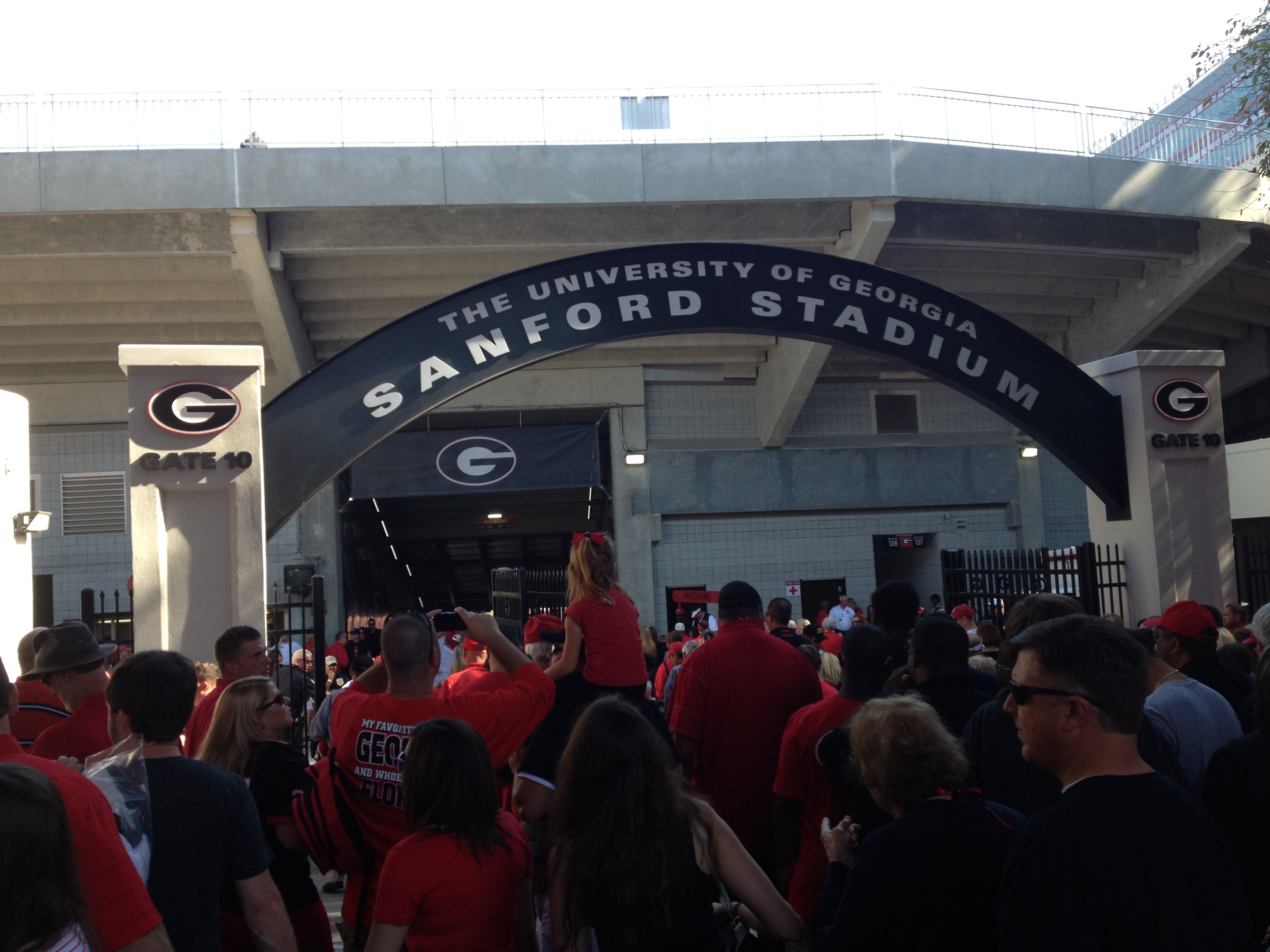
Mike and Bone have heard Glory, Glory" at the World Largest Cocktail Party and is among the Georgia's oldest and most lasting traditions is the school fight song, "Glory, Glory" which is sung to the tune of "The Battle Hymn of the Republic." It was sung at games as early as the 1890's, but arranged in its present form by Georgia's immortal musician-composer Hugh Hodgson in 1915. There have been many Bulldog songs through the years and at least two collections dating back to 1909 have been published, but none have enjoyed more acceptance than "Glory, Glory."
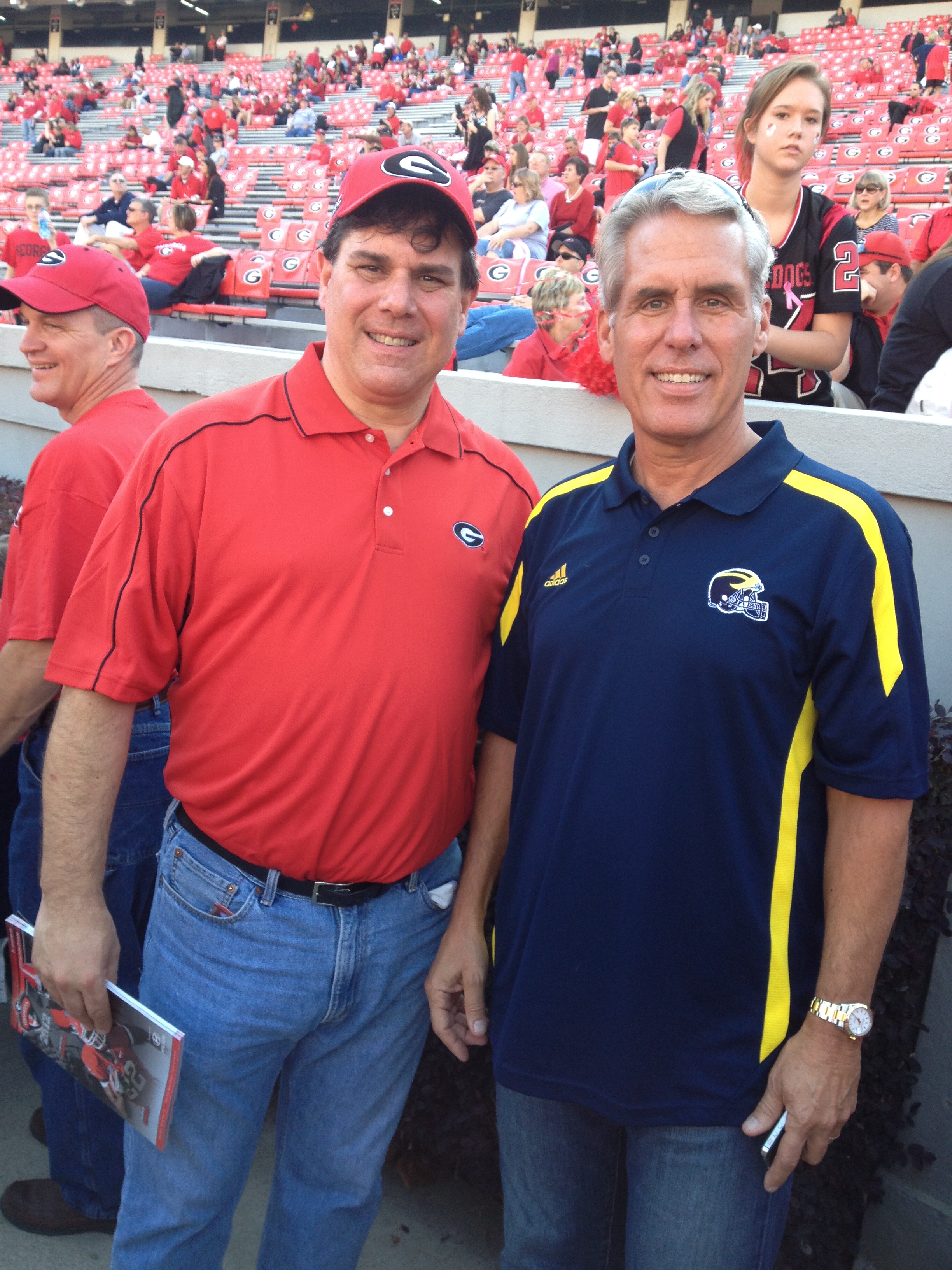
The venerable Hedges !

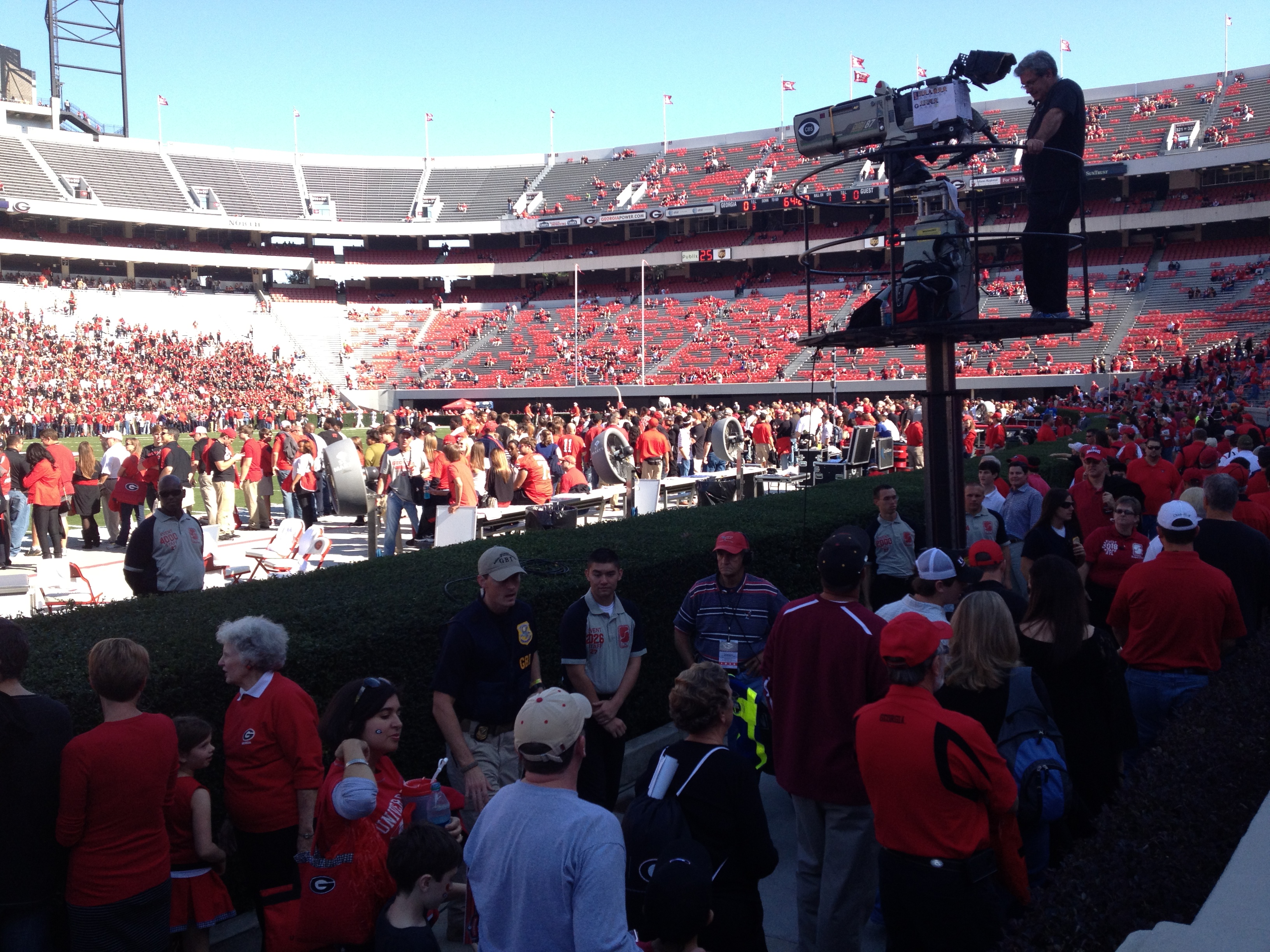
"Between the Hedges" is a reference to Sanford Stadium that dates back to the early 1930's. The famous Chinese privet hedges that surround Sanford's playing field were only one foot high when the stadium was dedicated in 1929 and were protected by a wooden fence. It was natural for a clever sports writer, referring to an upcoming home game, to observe "that the Bulldogs will have their opponent "between the hedges." At least one old-timer says the phrase was first coined by the legendary Atlanta sportswriter Grantland Rice.
No Kidding !! Thee Dawg, Uga !
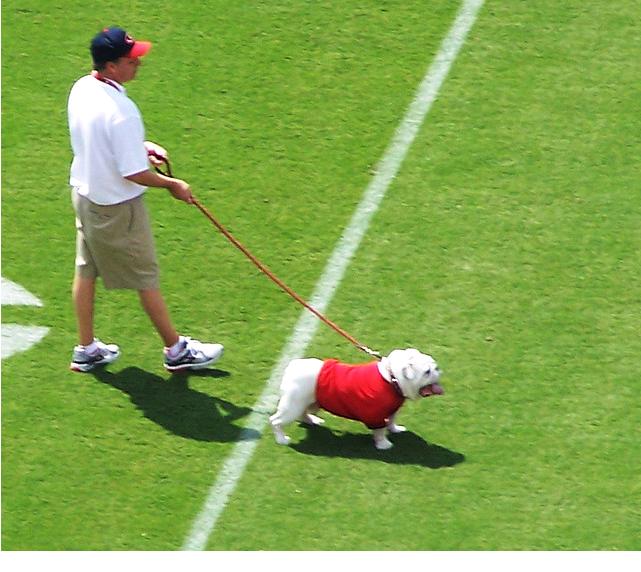
Of course Mike and Bone also had to check out Uga ! In the last 100 years of intercollegiate football, Georgia's Uga has established himself as the nation's most well-known mascot. The line of pure white English bulldogs, which epitomizes everything Georgia, has been owned by the Frank W. "Sonny" Seiler family of Savannah, Ga., since Uga I first graced the campus in 1956. Through the years, Uga has been defined by his spiked collar, a symbol of the position which he holds. He was given his name, an abbreviation for the university, by William Young of Columbus, a law school classmate of Seiler. Each of the Uga mascots is awarded a varsity letter in the form of a plaque, identical to those presented to all Bulldog athletes who letter in their respective sports. As determined and published by the Pittsburgh Press, the University of Georgia is the only major college that actually buries its mascots within the confines of the stadium. Ugas I, II, III, IV, V, VI, VII and VIII are buried in marble vaults near the main gate in the embankment of the South stands. Epitaphs to the dogs are inscribed in bronze, and before each home game, flowers are placed on their graves. The memorial plot attracts hundreds of fans and visitors each year. For the past 20 years, Uga's jerseys have been custom-made at the beginning of each season from the same material used for the players' jerseys. Old jerseys are destroyed. Uga's on-field home is a permanent air conditioned doghouse located next to the cheerleaders' platform, providing comfort in the heat of August and September.
"Game On!"
Mike and Bone
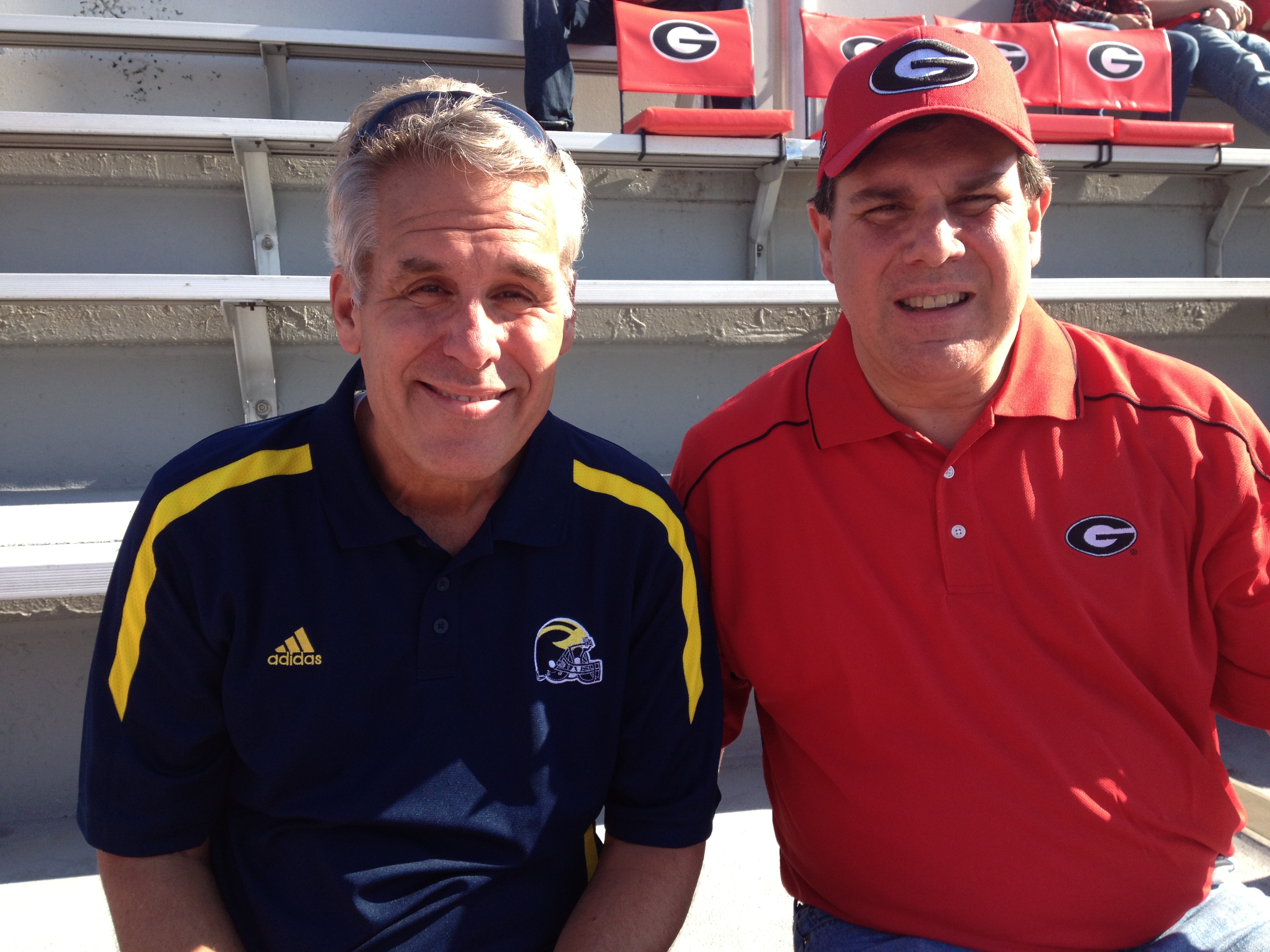
With hot dogs and sodas Mike and Bone found their seats in the North End zone (to replicate a Michigan experience!) Again, despite being in October and late in the afternoon, it was freakin hot and bright in Sanford!! Next was the Band, no not a British invasion, but Red Coats all the same!
The Red Coat Alumni Band!

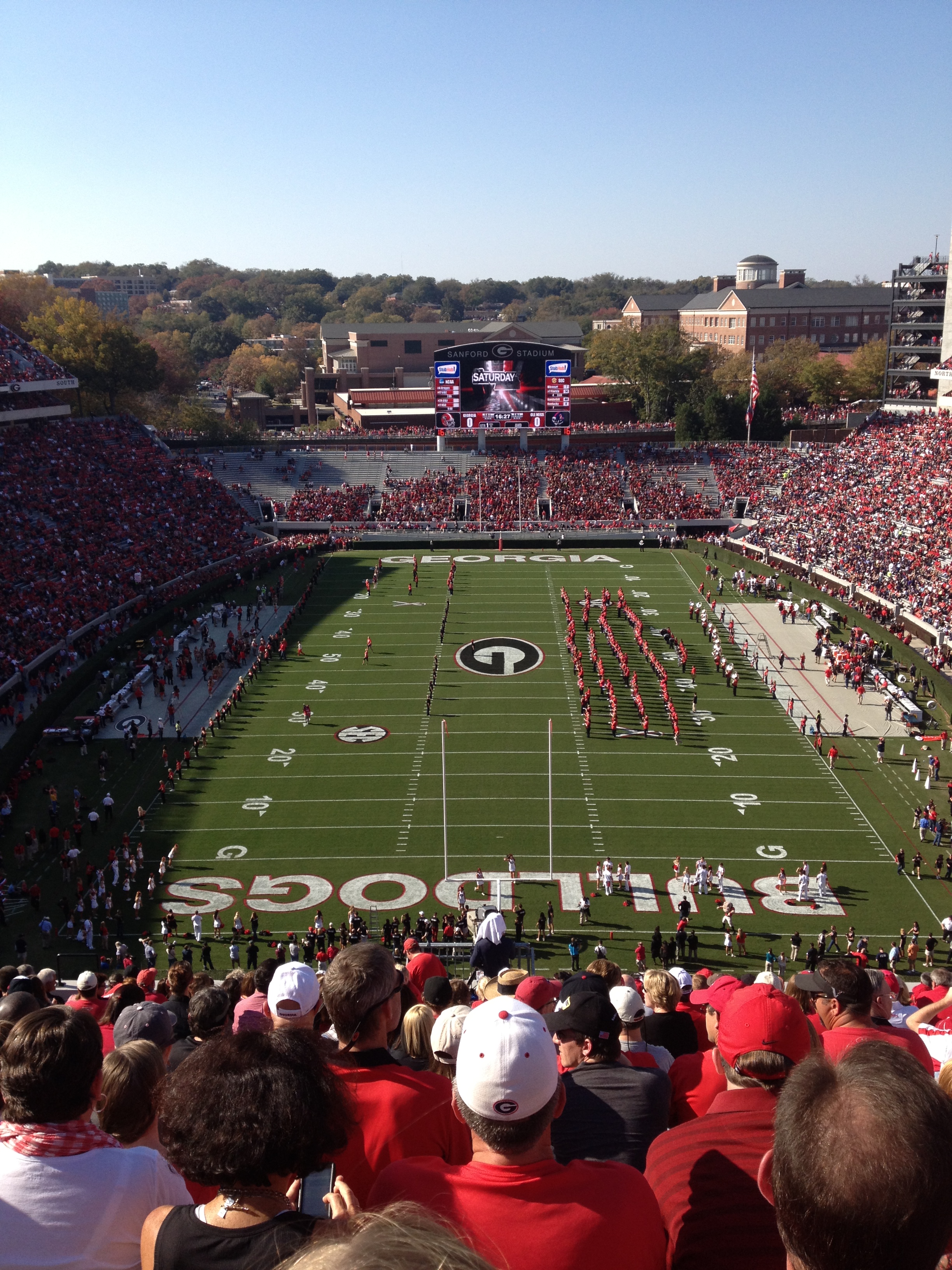
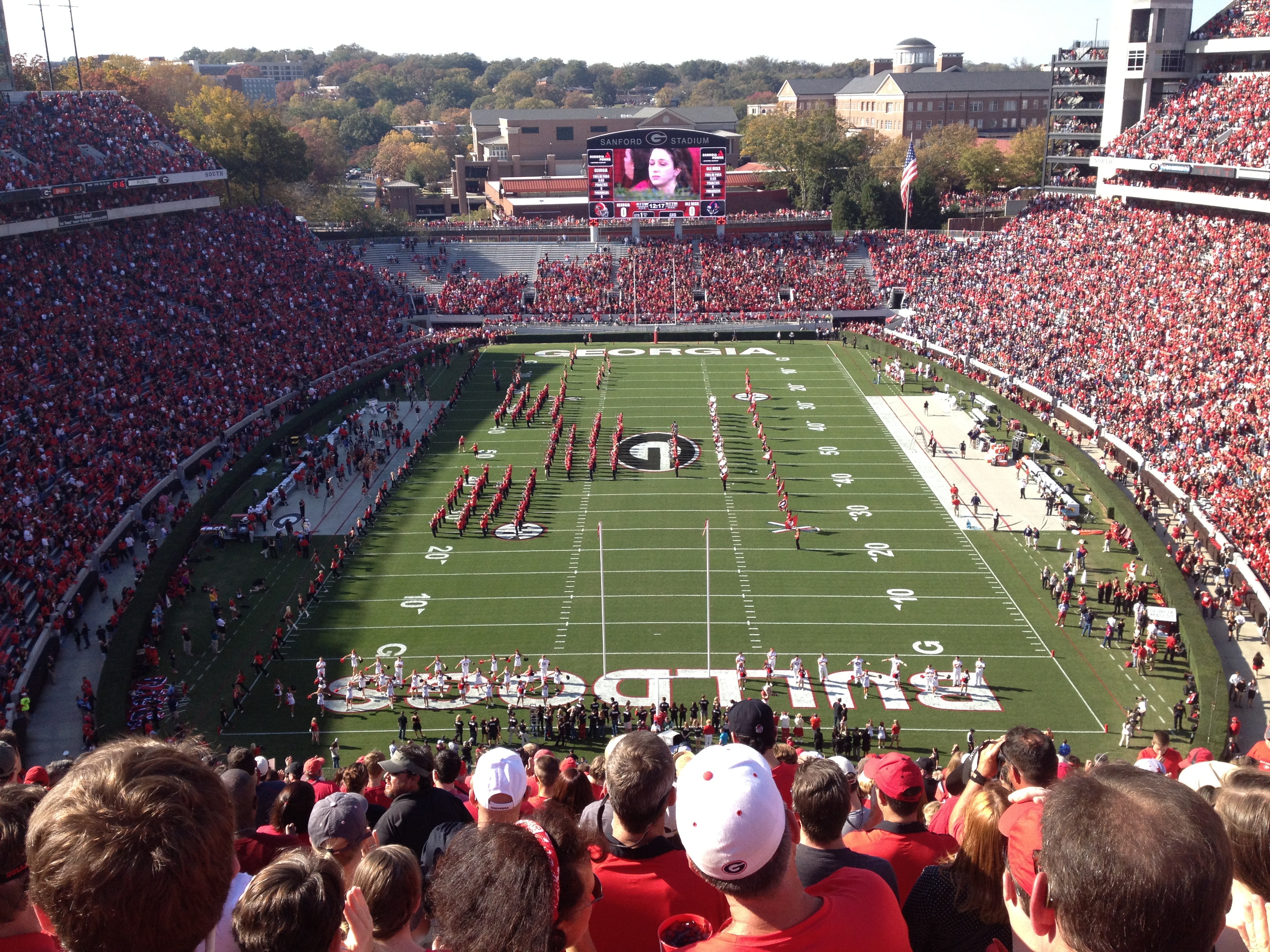
The Dawgs taking the Field
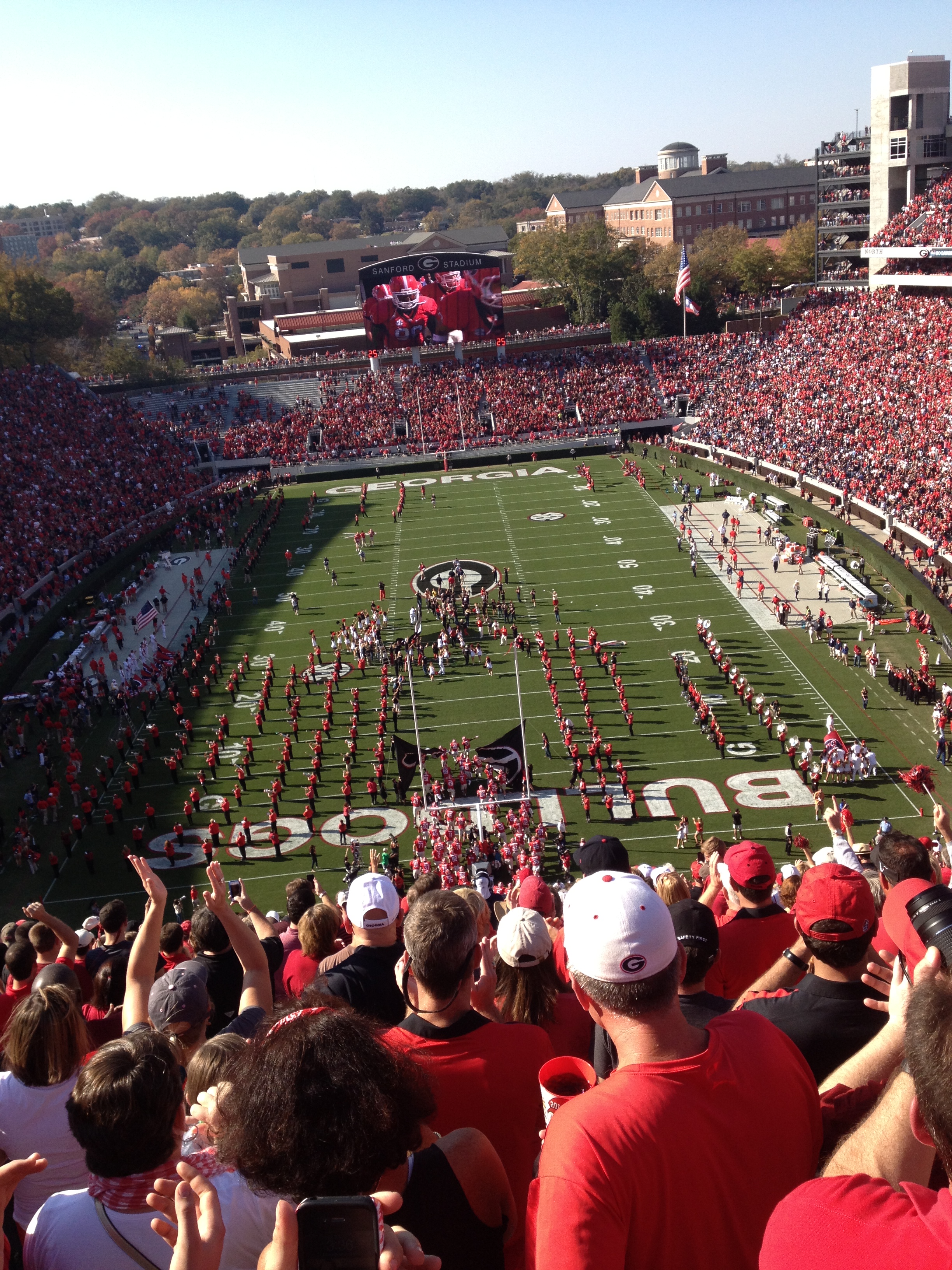


While the Game started, Mike and Bone were not sure anyone told the Bulldogs! Ole Miss looked faster and just plain wanting it more in the First Half.
Second Half: Just a Beat Down !!!
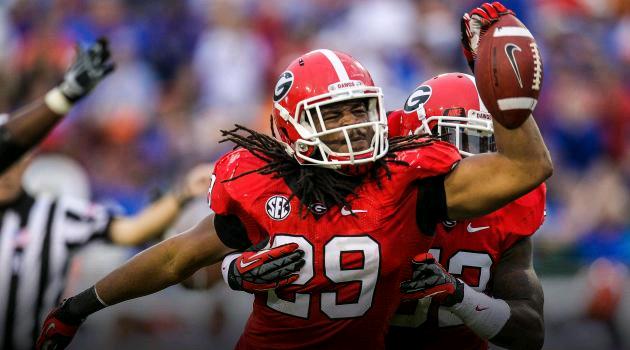
Mike and Bone watched one of Mark Richt's oldest trick plays to give the Dawgs the lift it needed to remain on track for a shot at the SEC title as the Dawgs woke up in the Second Half. Aaron Murray threw four touchdown passes and Georgia overcame their slow start to beat Mississippi 37-10 on Saturday and move one win away from a spot in the Southeastern Conference championship game. Murray pulled off a fake handoff on a 66-yard touchdown pass to Marlon Brown for the Bulldogs' first points. Richt, in his 12th season as Georgia's coach, brought the play from Florida State, where he was offensive coordinator under coach Bobby Bowden. Murray pulled off the well-executed fake handoff to Todd Gurley, who was swarmed by Ole Miss defenders as Murray hid the ball with his back to the line. Murray then threw to Brown, who was standing alone near the 40 when he made the catch. After being down 10 – 0 the Dawgs simply owned the rest of the game, scoring 37 un-answered points and completely dominating the second half. The Boys thoroughly enjoyed the beautiful day, the Red Coat Band, game, and were now ready for more football (LSU vs. Bama) and a few adult beverages !